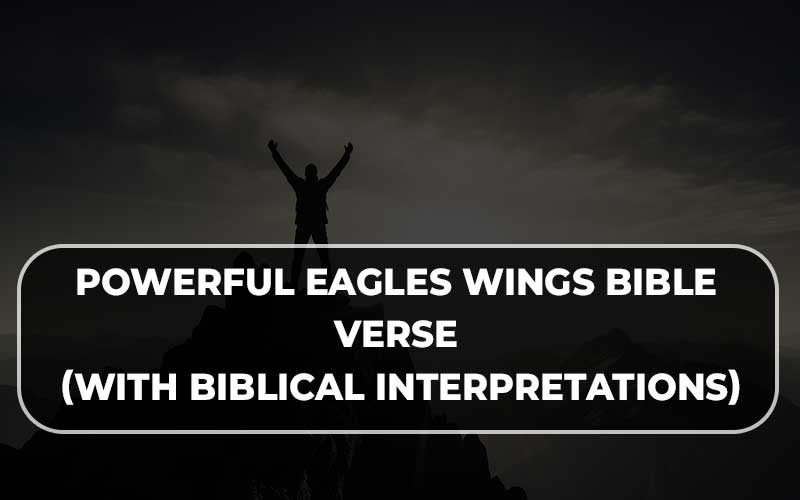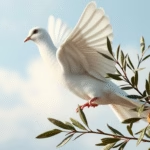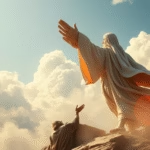The imagery of eagles and their wings is a powerful and recurring motif in the Bible, symbolizing strength, protection, and renewal. Throughout various passages, the Bible uses the metaphor of eagles’ wings to convey profound spiritual truths.
In this collection of 30 Bible verses about eagles’ wings, we explore the rich symbolism and deep insights that these verses offer, drawing inspiration from the majestic and soaring nature of eagles.
Eagles Wings Bible Verse
Exodus 19:4
“You yourselves have seen what I did to the Egyptians, and how I bore you on eagles’ wings and brought you to myself.”
The Israelites’ deliverance from Egypt is described as being carried on eagles’ wings, symbolizing God’s powerful and protective guidance.
Isaiah 40:31
“But they who wait for the Lord shall renew their strength; they shall mount up with wings like eagles; they shall run and not be weary; they shall walk and not faint.”
Waiting on the Lord is likened to mounting up with wings like eagles, emphasizing the spiritual renewal and endurance that God provides.
Psalm 103:5
“Who satisfies you with good so that your youth is renewed like the eagle’s.”
God’s satisfying goodness is portrayed as renewing one’s youth, akin to the rejuvenation of an eagle.
Deuteronomy 32:11
“Like an eagle that stirs up its nest, that flutters over its young, spreading out its wings, catching them, bearing them on its pinions.”
The protective and nurturing nature of God is depicted through the analogy of an eagle caring for its young.
Revelation 12:14
“But the woman was given the two wings of the great eagle so that she might fly from the serpent into the wilderness, to the place where she is to be nourished for a time, and times, and half a time.”
Symbolic imagery in Revelation depicts the woman being given eagle’s wings for protection and escape from danger.
Psalm 91:4
“He will cover you with his pinions, and under his wings, you will find refuge; his faithfulness is a shield and buckler.”
Seeking refuge under God’s wings signifies finding safety, protection, and the assurance of His faithfulness.
Jeremiah 48:40
“For thus says the Lord: ‘Behold, like an eagle swooping down, spreading its wings against Moab.'”
The imagery of an eagle symbolizes the swift and decisive judgment of the Lord.
Job 39:27-29
“Is it at your command that the eagle mounts up and makes his nest on high? On the rock, he dwells and makes his home, on the rocky crag and stronghold. From there, he spies out the prey; his eyes behold it from far away.”
The instinctive behavior of eagles, including their dwelling on high and keen eyesight, showcases God’s design and control over creation.
Hosea 8:1
“Set the trumpet to your lips! One like a vulture is over the house of the Lord because they have transgressed my covenant and rebelled against my law.”
The mention of a vulture, akin to an eagle, symbolizes impending judgment due to disobedience.
Lamentations 4:19
“Our pursuers were swifter than the eagles in the heavens; they chased us on the mountains; they lay in wait for us in the wilderness.”
The swiftness of eagles is employed metaphorically to describe the speed of pursuers, emphasizing the urgency of the situation.
Proverbs 30:18-19
“Three things are too wonderful for me; four I do not understand: the way of an eagle in the sky, the way of a serpent on a rock, the way of a ship on the high seas, and the way of a man with a virgin.”
The mysterious and wondrous ways of creation, including the flight of an eagle, are acknowledged with awe.
Matthew 24:28
“Wherever the corpse is, there the vultures will gather.”
The gathering of vultures is used metaphorically to depict impending judgment or the revealing of a situation.
Job 9:26
“They go by like skiffs of reed; like an eagle swooping on the prey.”
The fleeting nature of life is likened to the swift movement of an eagle pursuing its prey.
Micah 1:16
“Make yourself bald and cut off your hair, for the children of your delight; make yourself as bald as the eagle, for they shall go from you into exile.”
The baldness of an eagle, a symbol of mourning, is employed to convey the sorrowful exile of the people.
Obadiah 1:4
“Though you soar aloft like the eagle, though your nest is set among the stars, from there I will bring you down, declares the Lord.”
The lofty position of an eagle’s nest is used to illustrate the false sense of security, which God can bring down.
Ezekiel 1:10
“As for the likeness of their faces, each had a human face. The four had the face of a lion on the right side, the four had the face of an ox on the left side, and the four had the face of an eagle.”
The face of an eagle is part of the celestial beings’ imagery in Ezekiel’s vision, representing God’s divine attributes.
Matthew 17:5
“He was still speaking when, behold, a bright cloud overshadowed them, and a voice from the cloud said, ‘This is my beloved Son, with whom I am well pleased; listen to him.'”
The transfiguration of Jesus is accompanied by the overshadowing of a bright cloud, reminiscent of the protective nature associated with eagles’ wings.
Daniel 7:4
“The first was like a lion and had eagles’ wings. Then as I looked, its wings were plucked off, and it was lifted up from the ground and made to stand on two feet like a man, and the mind of a man was given to it.”
Symbolic imagery in Daniel portrays a kingdom with eagles’ wings, signifying both strength and subsequent transformation.
Revelation 4:7
“The first living creature was like a lion, the second living creature like an ox, the third living creature with the face of a man, and the fourth living creature like an eagle in flight.”
The eagle in flight is part of the celestial beings’ description in Revelation, representing divine attributes.
Psalm 18:10
“He rode on a cherub and flew; he came swiftly on the wings of the wind.”
The image of God flying on the wings of the wind conveys His omnipotence and sovereign control over creation.
Revelation 8:13
“Then I looked, and I heard an eagle crying with a loud voice as it flew directly overhead, ‘Woe, woe, woe to those who dwell on the earth, at the blasts of the other trumpets that the three angels are about to blow!'”
The cry of an eagle in Revelation is associated with impending judgments, emphasizing the seriousness of the events.
Ezekiel 17:3-4
“Say, Thus says the Lord God: A great eagle with great wings and long pinions, rich in plumage of many colors, came to Lebanon and took the top of the cedar. He broke off the topmost of its young twigs and carried it to a land of trade and set it in a city of merchants.”
The imagery of a great eagle and its actions symbolizes powerful nations and their influence.
Revelation 14:6-7
“Then I saw another angel flying directly overhead, with an eternal gospel to proclaim to those who dwell on earth, to every nation and tribe and language and people. And he said with a loud voice, ‘Fear God and give him glory because the hour of his judgment has come, and worship him who made heaven and earth, the sea and the springs of water.'”
An angel flying overhead carries a message of the eternal gospel, emphasizing the urgency and universality of God’s call.
Isaiah 63:9
“In all their affliction, he was afflicted, and the angel of his presence saved them; in his love and in his pity, he redeemed them; he lifted them up and carried them all the days of old.”
God’s compassion is likened to an eagle lifting and carrying His people, highlighting His intimate involvement in their lives.
Revelation 19:17
“Then I saw an angel standing in the sun, and with a loud voice, he called to all the birds that fly directly overhead, ‘Come, gather for the great supper of God.'”
The imagery of birds flying overhead is invoked in the context of a proclamation calling for divine judgment.
Isaiah 46:11
“Calling a bird of prey from the east, the man of my counsel from a far country. I have spoken, and I will bring it to pass; I have purposed, and I will do it.”
The calling of a bird of prey symbolizes God’s decisive and purposeful actions.
Revelation 8:1
“When the Lamb opened the seventh seal, there was silence in heaven for about half an hour.”
The silence in heaven, following the opening of the seventh seal, creates a moment of anticipation and awe.
Revelation 12:14
“But the woman was given the two wings of the great eagle so that she might fly from the serpent into the wilderness, to the place where she is to be nourished for a time, and times, and half a time.”
The woman being given the wings of a great eagle underscores divine protection during challenging times.
Revelation 4:8
“And the four living creatures, each of them with six wings, are full of eyes all around and within, and day and night they never cease to say, ‘Holy, holy, holy, is the Lord God Almighty, who was and is and is to come!'”
The constant proclamation of holiness by celestial beings with six wings emphasizes the perpetual worship of God.
Revelation 14:3-4
“And they were singing a new song before the throne and before the four living creatures and before the elders. No one could learn that song except the 144,000 who had been redeemed from the earth.”
The singing of a new song before heavenly beings signifies the unique worship offered by the redeemed, creating a harmonious and distinct praise.
Commentary:
The imagery of eagles’ wings in these 30 Bible verses encompasses a wide range of meanings, including divine protection, renewal, judgment, and the sovereignty of God. Eagles, with their majestic flight and keen eyesight, are used metaphorically to convey profound spiritual truths throughout the Bible.
The metaphor of being carried on eagles’ wings is frequently employed to illustrate God’s guidance and deliverance. In Exodus 19:4, God reminds the Israelites of how He bore them on eagles’ wings, emphasizing the power and care with which He led them out of Egypt. This imagery signifies not only the strength of God but also His watchful and protective nature.
Isaiah 40:31 beautifully captures the essence of spiritual renewal and endurance through waiting on the Lord. Those who wait on the Lord are compared to eagles mounting up with wings, suggesting a transcendent experience of rising above life’s challenges and finding strength in God’s presence.
The metaphor of eagles’ wings is also used to convey the concept of refuge and satisfaction in God. Psalm 103:5 depicts God as the one who satisfies with good, renewing the youth like the eagle’s. Seeking refuge under His wings becomes a symbolic expression of finding safety, nourishment, and the assurance of His faithfulness, as highlighted in Psalm 91:4.
The swift and decisive nature of eagles is employed metaphorically in various verses to depict judgment and the consequences of disobedience.
Also Read: Powerful Bless Others Bible Verse (With Biblical Interpretations)






Bible Commentary, Blog
30 Important Bible Verse About Arguing With A Fool (With Explanation)